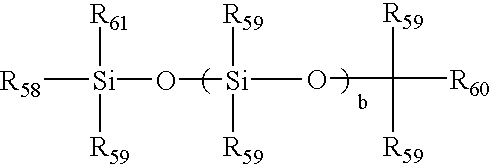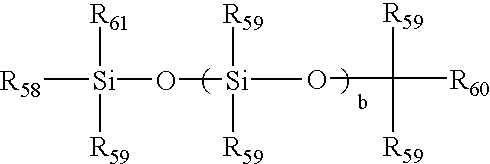Soft contact lenses
a technology of silicone hydrogel and contact lens, which is applied in the field of soft contact lens, can solve the problems of insufficient oxygen permeability to maintain a healthy cornea during long-term wear of contact lens, unacceptable to the contact lens wearer, etc., and achieves the effects of reducing the modulus of the hydrogel, lowering the modulus of the silicone hydrogel, and high oxygen permeability
- Summary
- Abstract
- Description
- Claims
- Application Information
AI Technical Summary
Benefits of technology
Problems solved by technology
Method used
Image
Examples
example 1
[0069]38.2 parts by weight of the product of PREPARATION 1 was combined with 28.8 parts MBM, 33 parts DMA and 1 part DAROCUR 1173 and diluted with 3-methyl-3-pentanol to make a reaction mixture in which the diluent made up 9% of the mass of the complete reaction mixture. The resulting reaction mixture was a clear, homogeneous solution. Polypropylene contact lens molds were filled, closed and irradiated with a total of 3.2 J / cm2 UV light from a fluorescent UV source over a 30-minute period. The molds were opened and the lenses were released into isopropanol and then transferred into deionized water.
[0070]The lenses were clear and had a tensile modulus of 205±12 psi, an elongation at break of 133±37%, and an equilibrium water content of 24.2±0.2%. Tensile properties were determined using an Instron™ model 1122 tensile tester (tensile modulus is equivalent to Young's modulus). Equilibrium Water Contents (EWC) were determined gravimetrically and are expressed as: % EWC=100×(mass of hydr...
examples 2-16
[0071]Reaction mixtures were made using the formulation of Example 1, but with amounts listed in Table 1. All reaction mixtures and lenses were clear.
[0072]
TABLE 1Silicone Hydrogel Formulations and Properties.Example1234CompositionPrep 138.233.527.622.3MBM28.833.539.444.7DMA33333333Darocur0.40.40.40.41173% of9754Diluent*EWC(%)24.2 ± 0.2 23.3 ± 0.3 22.4 ± 0.224.2 ± 0.3 Modulus(psi)205 ± 12 178 ± 11 136 ± 4 109 ± 3 %133 ± 37 156 ± 39 168 ± 48200 ± 58 ElongationDk (barrers)142.3144.9145.1109.3Example5678CompositionPrep 137.132.526.821.7MBM27.932.538.243.3DMA35353535Darocur0.40.40.40.41173% of107511Diluent*EWC(%)26.1 ± 0.3 25.8 ± 0.325.8 ± 0.325.8 ± 0.1Modulus(psi)179 ± 5 215 ± 7 132 ± 6 101 ± 4 %151 ± 42 106 ± 30195 ± 65179 ± 47ElongationDk (barrers)118.8129.6116.5107.9Example9101112CompositionPrep 135.43125.520.7MBM26.63136.541.3DMA38383838Darocur0.40.40.40.41173% of12775Diluent*EWC(%)29.4 ± 0.3 30.0 ± 0.3 26.6 ± 0.2 26.7 ± 0.3 Modulus(psi)215 ± 7 175 ± 7 132 ± 51 106 ± 4 %99 ± 22132 ...
example 18
[0075]Lenses were made using the procedure and reaction mixture described in Example 17, but with MPD in place of MBM. The lens properties are shown in Table 2.
PUM
| Property | Measurement | Unit |
|---|---|---|
| frequency | aaaaa | aaaaa |
| Young's modulus | aaaaa | aaaaa |
| tan δ | aaaaa | aaaaa |
Abstract
Description
Claims
Application Information
 Login to View More
Login to View More - R&D
- Intellectual Property
- Life Sciences
- Materials
- Tech Scout
- Unparalleled Data Quality
- Higher Quality Content
- 60% Fewer Hallucinations
Browse by: Latest US Patents, China's latest patents, Technical Efficacy Thesaurus, Application Domain, Technology Topic, Popular Technical Reports.
© 2025 PatSnap. All rights reserved.Legal|Privacy policy|Modern Slavery Act Transparency Statement|Sitemap|About US| Contact US: help@patsnap.com



